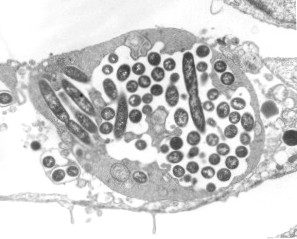
Legionella are bacteria that can occur in any household and can cause dangerous diseases in humans, such as Legionnaires' disease. A regular legionella examination with the own drinking water is therefore obligation for each house owner, a landlord is even legally obligated in Germany in accordance with the drinking water regulation to it.
Legionella testing obligation until 31. December 2013
In order to obtain information about the condition of the in-house drinking water, a legionella test must be carried out. This involves taking two water samples from equipment such as a boiler, as it is very important that the water being tested has been in the pipe for at least four hours without circulation. If the water is taken from a tap, aerators and sealing rings must be removed beforehand, as legionella prefer to settle in such places. This is the only way to ensure that an investigation result is not falsified. There are also two samples to be taken from running water.
What is legionella testing?
All four samples are sent to an accredited laboratory for analysis. There, the result of all four samples is used to calculate an average value in order to obtain a clear result. The detailed result report provides information on whether your water contains legionella or not, or if it does not contain legionella. Whether the contained amount is dangerous to the health of the residents.
What to do about legionella?
If the results show that the concentration of legionella is too high, you will receive recommendations for action that must be followed in order not to endanger your own health.
If you are a tenant of an apartment in a multi-family building and you notice legionella, it is imperative that you inform your landlord and have the entire system tested. The information you receive from the results report must also be immediately forwarded to the health department, according to the Drinking Water Ordinance.
For the house owner itself results in Germany from the drinking water regulation the obligation to inform all inhabitants of the building about the result of the Legionellenprufung, all the same whether positively or negatively.
If the test shows that the Legionella count in the drinking water exceeds the legal maximum limit of 100 Legionella per 100 ml, the operator of the water system or the water supplier must be informed. the owner of the house is obliged to restore the target condition. To achieve this, there are four different disinfection options, but they must be individually adapted to the structural conditions of the house, because all four variants contain both advantages and disadvantages. Unfortunately, poor examination results often entail structural changes, which can cause costs. A final consultation and contact with a plumber is therefore advisable in order to be able to estimate the entire scope of the work at an early stage.
What are Legionella actually?
Legionella, also known as Legionella, are rod-shaped bacteria found in water. If Legionella bacteria are detected in your drinking water, there is an acute need for action, because they cause the so-called Legionnaires' disease. Especially in showers and other drains where water is dispersed in the air, Legionella can lead to dangerous infections. In contrast, healthy people rarely fall ill when ingesting bacteria through drinking.
What is Legionnaires' disease?

The disease is characterized by chills and severe fever. Temperatures of up to 40 degrees are not uncommon. Frequently also limb pain and nausea belong to the clinical picture. Although pneumonia and kidney failure are rare, they can be extreme consequences of Legionnaires' disease.
Legionella can also cause the so-called Pontiac fever. This disease is much milder than the Legionnaires' disease. In addition, such infections were not recorded so often.
Where do legionella live? Where is the highest risk of infection?
Legionella are mainly found in warm water. If, in addition, no circulation takes place, the bacteria feel most comfortable. As already mentioned, the greatest risk of infection for humans is when water is dispersed in the air, i.e. atomized. A classic example, where non-circulating water is stored at higher temperatures, is the boiler or other storage facilities that virtually every homeowner finds in the basement. The water stored there is used for showering, is atomized and inevitably inhaled by people.
How to get infected?
The risk of endangering one's own health through Legionella does not usually exist at home, however, but rather in hospitals or doctors' offices, as an increased occurrence of the bacteria is recorded here. Since plastic serves as a food source for legionella, you should nevertheless always replace the sealing rings on water taps.
What to do against legionella?
In order to find out whether one's own drinking water is contaminated by Legionella, a Legionella examination or a Legionella test can be carried out. a legionella test should be carried out. However, you should not carry out such an examination on your own, but leave it to a specialist. If it is determined that your drinking water is contaminated, this person can provide you with appropriate information about possible disinfection or other immediate measures. First of all, it is necessary to stop the multiplication of the bacteria in order to prevent the transmission of diseases.
Since in the case of contamination by Legionella a correct water composition according to the drinking water ordinance is no longer given, the health department or. inform the responsible environmental agency and notify them of the result of the investigation.
The drinking water ordinance imposes certain obligations on owners of apartment buildings in connection with legionella and drinking water testing. These must be adhered to in order to avoid sanctions under the Drinking Water Ordinance and damage to the health of residents.
The Drinking Water Ordinance requires initial testing of water for legionella in drinking water systems by 31.12.2013 ago. After that, checks have to be made at regular intervals.
Control of Legionella
Legionella is a non-spore-forming gram-negative bacterium that lives in fresh water and is usually found in swimming lakes, puddles of water or moist soil, and is generally completely harmless to healthy people. A risk of infection only arises when legionella in aerosol form enter the respiratory system and the lungs. Therefore, wet rooms in hotels, clinics, care facilities or swimming pools are considered risk areas, as are whirlpools or the ever-popular bubbling water attractions in leisure pools. Ventilation systems, water tanks or cooling towers also offer the bacteria an optimal habitat and multiplication area.
Legionella can make you sick
In particular, the elderly, sick, immunocompromised and small children are at high risk of contracting a legionella infection, the so-called legionnaires' disease. The symptoms are rather unspecific with chills, fever, nausea and vomiting as well as aching limbs. Since a Legionella infection can lead not only to acute pneumonia but also, in the worst case, to acute kidney failure, the symptoms should not be underestimated.
Prevention and control of legionella
In order to effectively prevent legionella, it is advisable to consider some important criteria already when planning a new building. So you should not only pay attention to the choice of a suitable material, but also to a sufficiently high flow rate of the water to avoid dormant corners. If possible, high-risk areas should be avoided and boilers should not be connected in parallel. Regular maintenance, inspection and cleaning of boilers is essential. In addition, a water test for legionella should be carried out at regular intervals.
If there is a legionella infestation, there are different ways to fight the bacteria. This is how a treatment with chlorine dioxide or ozone can be done. While chlorine dioxide has a high disinfection effect regardless of the pH value and protects against reinfection with legionella by breaking down biofilms in the pipe system, ozone reacts without residues to form oxygen. Because it has no depot effect due to its short half-life, ozone is practically only used in air washers and cooling towers.
Other, less effective and disadvantageous methods of combating Legionella include hot water flushing systems. Since a water temperature of at least 70°C is necessary to safely combat Legionella, there is not only a risk of scalding, but the flushing also means an enormously high energy input. In addition, reliable thermal disinfection is impossible with longer pipe systems. A continuous boiler temperature above 55°C reduces the legionella load in the water storage tank, but not in the pipe system. Also the treatment with UV rays, if necessary also in connection with ultrasound is to be regarded as critical due to the missing depot effect and the insufficient protection against reinfections. In addition, there are high investment and space requirements.
Who bears the costs of legionella testing?
The costs of a legionella examination in a multi-family house with 8 parties are approx. 200 euros. In principle, these costs are to be borne by the owner or. to be borne by the landlord.
However, the cost of drinking water testing can be passed on to tenants in the utility bill. This is in accordance with. § 2 BetrkV around "costs of the enterprise of a house-own hot water supply system". However, only the costs of the orienting examination are apportionable, not however the costs of further examinations and reorganization measures with legionella infestation.